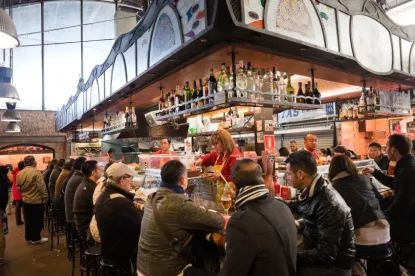Who gets what when a lease of real property is over?
This is a question that can be problematic for both landlords and tenants. If the tenant installed additional improvements or made alterations to the premises, will they become the landlord's property when the lease terminates?
What about "trade fixtures" that the tenant installed that were needed specifically for the tenant's business; and what exactly is a "trade fixture"? Or what about inventory, equipment, or other personal property abandoned by the tenant after the tenant leaves the premises? These issues come up often in commercial leases and are best addressed when drafting the lease, not when the situation arises.
Improvements
Tenants often make additional improvements or alterations to the leased premises during the term of the lease. If the lease is silent on what happens to the improvements or alterations once the lease terminates, the landlord and tenant could end up in a costly legal battle to determine who owns the improvements or alterations.
Any additional improvements or alterations, other than so-called "trade fixtures" made by the tenant will likely become the landlord's property once the lease terminates since the landlord owns fee title to the real property on which the premises are located and permanent improvements or alterations cease to be personal property (i.e., bricks, uninstalled shelving refrigeration equipment) and become a part of the landlord's real property unless they are determined to remain the tenant's property because they are mere "trade fixtures," but there is no need to leave this determination to a judge or jury.
In order to avoid any confusion when the lease terminates, the landlord and tenant should include a clear provision in the lease stating what will happen with the improvements made by the tenant when the lease terminates.
Typically, leases provide that the improvements and alterations become part of the premises and belong to the landlord, which memorializes the default rule. But it is also possible that in some circumstances, the landlord does not want the improvements after the lease terminates. In that case, the landlord may want the tenant to restore the premises to the condition they were in prior to the commencement of the lease.
The landlord should include a provision in the lease that allows the landlord to either keep the improvements as part of the property or require the tenant to remove the improvements and restore the premises, at tenant's expense, at the termination of the lease. The landlord also should consider an approval right over any improvements made by the tenant. Regardless of the plan, the fate of the improvements and alterations should be addressed when the lease is drafted.
Fixtures: Are They the Landlord's Real Property or the Tenant's Personal Property "Trade Fixtures"?
Trade fixtures are items that are installed in the premises by the tenant solely for the purpose of conducting the tenant's business. As stated above, fixtures are often considered part of real estate, but this can be an unclear area of the law, and property installed by a tenant may be considered a trade fixture that can be removed by the tenant at the end of the lease.
In North Carolina, as in many states, it's the "intent of the parties" that determines whether an improvement is a real property fixture that belongs to the landlord or a trade fixture that belongs to the tenant. If the parties know what the improvements will be, such as gas pumps, underground gas storage tanks, and large overhead awnings for a gas station; refrigeration equipment and shelving for a grocery store, or stoves and ovens in a restaurant, the lease should clearly state whether the parties intend for them to be real property fixtures that will belong to the landlord or trade fixtures that will belong to the tenant.
But many alterations and improvements are not, or cannot be, spelled out, especially in a long term lease when such items don't even exist at the time the lease is executed. When there is a dispute in those cases, the "intent" of the parties will be determined by a judge or jury "inferring" from the nature of the property and its use the unexpressed "intent" of the parties unless the parties have the forethought to amend or supplement the lease with an explicit expression of their intent as to the particular item.
The status of the property as a trade fixture may depend on simple things such as the way the item is installed, the life expectancy of the item, and how easily the item may be removed. It's easy for a landlord and tenant to disagree when deciding whether an item installed by the tenant is a permanent part of the real property or a trade fixture. Therefore, it is best to include a provision in the lease that clearly states whether the fixtures become a part of the real property and thus the property of landlord or if the tenant has the option (or can be forced at landlord's option) to remove the fixtures at the end of the lease.
Fixtures are also often a point of contention when issues of solvency are in play, such as when a personal guarantee of a lease expires after a certain period of the tenant's demonstrable solvency. Since fixtures typically are the property of the landlord while they are installed, the tenant could be in a situation where the fixture is an asset of the landlord on the books, but the tenant carries the debt as a liability. This can impact a traditional solvency equation.
There also are practical differences between certain fixtures and the way they impact the property. A bolted down, but otherwise portable, commercial stove is much less impactful than a commercial stove hood and vent, which likely is tied directly into the roof system. The former is easily removed, the latter is not. Regardless of the specific situation or item, it's critical to thoughtfully consider the fixtures that are or could be installed by the tenant and to determine, and, on the front end explicitly state in the lease, how those items will be handled.
Abandoned Property
Another complicated scenario occurs the tenant leaves the premises (after termination of the lease or earlier) and abandons some of its personal property or inventory. Sometimes the tenant simply leaves behind trash which the landlord may dispose of, but there are times when tenants leave behind valuable inventory or equipment. Those situations can become difficult for the landlord if the lease is silent on the issue. The landlord often simply wants the tenant to remove its personal property so that the landlord is not responsible for it and the premises can be prepared for the next tenant. However, if the tenant refuses to pick up its property, or the landlord cannot locate the tenant after the lease terminates, the landlord will have to do something with property that does not belong to the landlord.
Absent clear remedies in the lease, the landlord may have to face arguments from the tenant about a variety of things, from mishandling of the items, to unjustified conversion and sale, and the like. Even if the landlord is in a strong position regarding such arguments, it often is the actual fight to win that is more costly, both from the standpoint of money and time. It's simply better to avoid the dispute altogether with thoughtful and appropriate lease provisions that clearly state the landlord's options regarding the tenant's abandoned personal property.
Conclusion
All the potential problems described above will only be problems if the lease does not address these issues explicitly. Both the landlord and tenant can avoid headaches in the future by taking the time to carefully draft the lease and include provisions to address improvements, alterations, fixtures, and abandoned personal property.





 />i
/>i
